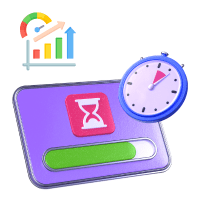
Before we start unfolding the concepts of employee engagement, and ways to measure employee engagement, and improve employee engagement, we need to be clear in our heads that employee engagement is not employee satisfaction.
The reason I am making this clear right here is that the latter terminologies tend to be misunderstood to be the same thing.
What is Employee Engagement?
Employee engagement is the degree of an employee’s cognitive, emotional, and behavioral engagement toward organizational outcomes.
Employee engagement is not just one way of commitment towards the organization from the employee but a relationship of mutual understanding, trust, integrity, and respect between the employee and the organization.
Simon Sinek defines employee engagement as “ When people are financially invested, they want a return. When people are emotionally invested, they want to contribute.”
As per State of the Global Workplace Report, Gallup concluded that 85% of the employees are not actively engaged at work. These statistics suggest that a major chunk of the workforce across the globe either sees their work negatively or does a bare minimum part of their job for the sake of bread and butter.
Levels of Employee Engagement
Based on the perception of employees for their organization, there are 4 levels of employee engagement:
Highly Engaged
- Employees who fall under this category possess a personal attachment towards their organization.
- Such employees are highly committed, highly engrossed, and passionate about their work.
- For them, the organization’s goal is their personal goal for success.
- Such employees are less tend to switch their jobs for career growth as they rarely find any need for the latter.
- These employees also prefer to motivate other employees to perform their best at work.
Moderately Engaged
- Moderately engaged employees are the ones who though like to continue working in their organization but something holds them back to increase their bar of performance.
- Such employees always find room for improvement in their organization.
- These employees rarely ask for more responsibilities and are likely to underperform in the future.
Barely Engaged
- Barely engaged employees are a high turnover risk for their organization
- These are employees who lack motivation for their position and are always in search of better opportunities.
- They only perform to the level which is enough to get by.
Disengaged
- These are the employees who hold a negative opinion about their workplace.
- Such employees are disconnected from the organization’s mission, goals, and future.
- Disengaged employees also become hindrances in the productivity of other employees.
Employee Engagement Categories Framed by Gallup
Actively Engaged
- These employees are known for their passion, creativity, optimism, loyalty, resilience, and strong work ethics
- Such employees actively take part in suggestions to improve any processes of their organization.
- Such employees are proactive on their own to come up with an innovation or improvisation for their organization.
- They prove their work to be beyond the roles and responsibilities assigned to them.
- These employees share meaningful relationships with their peers and colleagues.
Not Engaged
- These employees tend to perform allotted and set roles and responsibilities for their organization.
- They won’t be proactive toward the organization’s growth and success but would be resistant toward change and growth.
- Such employees are not team players rather they prefer to work independently from others.
- These employees sometimes require an extra push to become engaged employees for their organization.
Actively Disengaged
- Actively disengaged employees tend to make excuses for their underperformance.
- Also, it is found that they often tend to take their negative talk outside the organization to crib about their workplace.
- Instead of fixing their weaknesses, they tend to find loopholes in their workplace.
Top 12 Strategies to Measure Employee Engagement?
Establish Employee Engagement Goals
The employee engagement goals should be such that they differentiate an actively engaged employee from an actively disengaged employee.
Some examples of employee engagement benchmarks are listed below:
- Check if your employee feels that their opinions matter at work
- Check if your employees see their career growth and skill upgradation at their workplace
- Check if your average employee’s Net promoter score is 9 or above
- Check if your employee absenteeism is low or not
- Check if there is a high level of employee engagement and retention for an x period of time.
- Check if your staff regularly opens an ‘employee newsletter’ to stay updated on the company’s news or not.
Use of E-Mails
Since emails are the oldest and yet trending form of formal communication in all organizations, therefore checking on parameters like open rate, click-through rate, and location, an employer can measure his employees’ engagement.
An AI-based tool like ContactMonkey is a great boon in such cases wherein the above-mentioned three engagement metrics can be detected and also can be enhanced.
Let’s understand in-depth these three metrics below:
Open Rate
This lets you know how many employees are showing interest in your company’s news and events. High open rates for emails are a good sign which shows that the employees are highly engaged.
Also, you can compare past and current email campaign engagement to check where the engagement was higher.
Click-through Rate
- This metric shows how many employees are aware of the news shared through email campaigns.
- Also, this metric show if your employee engagement ideas are working or not
- Also, this metric helps you figure out which newsletter content was more engaging. This result would give you an idea to roll out future models of content.
Location
- By using these metrics, you get to know which department of your organization is more engaged
- This in turn helps you build engagement strategies for your employees

Pulse Surveys
- The method of pulse surveys works great in measuring employee engagement.
- This survey is short and focused on a specific question
- The key to conducting this survey is simply zeroing in on three types of questions:
- Satisfaction questions – Is your team an inspiration for you to perform best at your work?
- Opportunity questions – Do you find enough opportunities for growth in your team?
- Alignment questions – Are you asked to put your say in major decisions of your team?
Learn how to create pulse surveys step by step here
Calculate eNPS
This tool is great for calculating precise and numeric engagement scores for your employees.
eNPS is calculated as a difference between your most engaged employee and the least engaged employees.
Questions asked under this tool are – On a scale of 0-10, how likely you would recommend this organization as a place of work?

Setting up one-on-one Virtual Meetings
Though it can be said to be one of the traditional methods to resolve issues, seeking feedback, and confrontation the method still provides an effective output.
This method lets you gauge the non-verbal cues of your employee. While doing the session, you are suggested to show great listening and attentive gestures. This ensures the employee is being given enough importance and attention. Also, this results in sharing genuine issues and concerns too along with feedback.
Below are some sample questions that can be asked your employee:
- Name one thing about your workplace that you find most positive.
- Name one thing about your workplace that you think requires significant improvement.
- Describe your organization in three words.
Create Focus Groups
In large organizations where one-on-one meetings are a bit challenging in execution, creating focus groups solves the purpose to check employee engagement.
Used widely in market research, focus groups help you to gauge your employees’ likes, dislikes, perspectives towards your organization, and so on.
Callouts to employees can be sent through company newsletters by which the employees from different departments are chosen.
Pre-planned questions like :
- Do you agree with what our company’s definition of “success” say?
- Is there anything that limits your growth in the organization?
- Are you well aware of your role in contributing to the organization’s growth?
Checking Employee Retention
This method directly gives us the data for actively engaged employees. This includes asking questions to employees related to how their employees see their future in the organization.
- You can frame Yes/No questions like
- Do you see yourself in the organization in the next 2-3 years?
- Are you proud to work for your organization?
Employee Productivity
One of the easiest and most direct parameters to measure your employee engagement is employee productivity. Employee productivity is a parameter to test your employee how effectively he delivers output to your organization.
Recognition Metrics
This metric includes asking employees questions like:
- What is the frequency at which you receive recognition in this organization?
- Do you feel that the recognition you receive is meaningful?
Happiness Metrics
Happiness metrics include asking questions to employees like
- How would you rate your level of happiness on a scale of 0-10?
- Do you find the flexibility of taking offs in our organization when you feel so?
- Happiness is one of the top-of-mind metrics to conduct for employees.
Relationship with Peers
Measuring the quality of your employee based on his relationship with peers also would help you find employment engagement.
Such employment engagement questions may sound like this:
- Do you collaborate with your peers well?
- Is communication between you and your peers genuine and transparent?
- Based on trust, how would you rate your peers around in our organization on a scale of 0-10?
Relationship with Manager
As per Office vibe’s data report, it was found that 75% of the employees who leave their job is due to their manager or leadership.
These metrics include questions like:
- Is your direct manager open for help when you need them?
- Are you satisfied with the frequency of meeting your direct manager?
- Do you trust that your direct manager cares about your well-being?
Ways to Improve Employee Engagement
Are your employees engaged? If not, don’t panic, by doing a little shift in your organizational culture you can make it work.
Recognize Their Hard Work
It may sound click and the oldest way of encouragement but true. As soon as you start to appreciate your employee’s hard work regularly and not constantly, it gives them a sense of engagement with their projects and work.
Invest in Their Professional Development
According to Tiny Pulse’s Engagement Report, it is found that only 25% of employees say that their organizations provide professional development opportunities and learnings.
Let your Employee Pursue Pet Projects
Doing the same kind of work every day can become monotonous without any doubt. Let them pick tasks of their interest from different departments and feel a change in their daily routine.
Provide Flexible Scheduling and Remote Work
Which employee won’t like a perk coming his way? To increase engagement, providing remote work or flexible scheduling (occasionally) can make a difference. This motivates the employee to enhance productivity when he gets the liberty of doing the work at his choice of place.
Plan Team-Building Days
Employees are more tend to engage with their coworkers. So, planning potlucks, and happy hours can work great in building team bonds. This can further result in employee engagement in the workplace when employees start familiarizing themselves with their workplace more.
Start Treating your Employees Like Adults
To make your employees more engaged in their work, you need to make them feel the ownership of their project. Therefore, to do so you need to stop micromanaging their tasks and hover around after every half an hour or so.
Conclusion
Practicing activities to enhance employee engagement is nothing but bringing your employees to the closest periphery of your organization. Your employees should feel a sense of belongingness in their workplace. Ultimately, employee engagement activities should bring a sense of pride and loyalty in employees’ minds toward their organization.
The employees should end up becoming great advocates for their organization. They should go the extra mile to bring the same faith for their organization into the minds of their clients, users, customers, etc. Also, parameters like fewer leaves, grievances, sick absents, etc are the indicators that tend to tell you how your employee feels engaged or disengaged in the organization.








